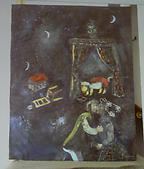In 1937, Nazi officials exhibited many of their confiscated artworks at the Haus der Deutschen Kunst in Munich. Hildebrand Gurlitt (although half-Jewish, and the cousin of the “degenerate” composer Manfred Gurlitt) arranged to control and sell the pieces, but obviously saved and stored the works for his own use. Dr. Uwe Hartmann, director of the provenance research unit at Germany’s Federal Office for Central Services and Unresolved Property Issues, confirmed that Hildebrand Gurlitt acquired many of the pieces himself from museums and fleeing owners.
Art specialists, speaking to the Deutsche Welle, added that Gurlitt was one of the art dealers who was directly and indirectly a beneficiary of the policies of Nazi persecution and expropriation of the Jews. Gurlitt and his son, to whom the pictures now apparently belong, were profiteers of the Nazi regime. And how to deal with his property and his enrichment under the Nazis that continues until this very day – that is something fundamental that the art world needs to think about.
There are those who say that the trove was no secret, and there is an even larger network of art hoarders in Europe, living off covert sales at complicit auction houses.







